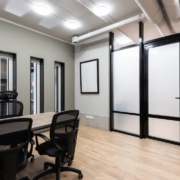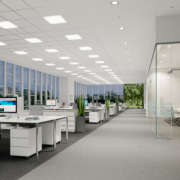Comprehensive Guide to Office, Warehouse, and Outdoor LED Lighting Solutions
Lighting is one of the most powerful design and operational elements in any environment, influencing everything from productivity and safety to aesthetics and energy efficiency. Modern businesses, organizations, and facility managers are no longer limited to outdated fluorescent or incandescent setups—they now rely on advanced LED solutions that deliver long-term value. Whether it is office lighting designed to enhance focus, warehouse lighting optimized for visibility and safety, or outdoor LED lights installed with pole mounted and wall mount fixtures for security and aesthetics, each choice plays a role in creating an integrated lighting strategy.
By treating these lighting applications not as separate silos but as connected layers of a complete system, businesses can align visual comfort, energy efficiency, and performance. Let’s dive into how each of these lighting categories relates to one another and why a well-rounded approach creates superior results.
Office Lighting: Enhancing Productivity and Comfort
Modern workplaces are designed to encourage focus, reduce fatigue, and support employee well-being. Office lighting is at the heart of this. A well-chosen office light fixture does far more than brighten a space—it reduces glare, balances brightness levels, and mimics natural daylight to help staff remain energized throughout the day.
Key considerations for effective office lighting include:
- Balanced brightness: Avoid over-illumination that causes eye strain while ensuring workstations have enough light for tasks.
- Color temperature: LEDs can provide warmer tones for relaxation zones and cooler tones for meeting rooms or task areas.
- Energy savings: LED office fixtures consume significantly less energy than fluorescent lights, reducing operational costs.
- Design flexibility: Sleek fixtures integrate into modern ceiling panels, making offices look more professional and inviting.
Well-planned office lighting ties directly into larger facility goals. For instance, the same energy efficiency strategies applied to offices also extend into warehouses and outdoor spaces, ensuring a consistent corporate sustainability approach.
Warehouse Lighting: Safety and Performance at Scale
Warehouses present unique challenges—high ceilings, large open spaces, and frequent use of heavy equipment. Proper warehouse lighting is critical to ensure safety, reduce accidents, and improve productivity. High bay lights are often the solution of choice because they provide powerful illumination that reaches the ground without creating shadowy or dark areas.
Advantages of warehouse LED high bay lights include:
- Uniform coverage: Reduces blind spots for forklift operators and workers handling materials.
- Durability: Designed to withstand dust, vibrations, and demanding industrial conditions.
- Energy efficiency: High bay LEDs consume up to 70% less energy than traditional HID lamps.
- Longevity: Minimal maintenance means fewer interruptions to warehouse operations.
Here’s where the connection lies: the same technology powering office LEDs—high efficiency chips, advanced optics, and smart controls—scales up to warehouses. This continuity allows businesses to adopt a single lighting philosophy across their entire property, from office cubicles to massive racking aisles.
Outdoor LED Lights: Security, Branding, and First Impressions
If office and warehouse lighting focus primarily on indoor comfort and safety, outdoor LED lights set the tone for how a facility looks and feels from the outside. Parking lots, pathways, building facades, and entryways all require reliable illumination not only for visibility but also for security and customer impressions.
Benefits of outdoor LED lighting include:
- Security: Bright, consistent illumination deters trespassers and improves surveillance footage quality.
- Aesthetic impact: Architectural outdoor lighting highlights building facades and enhances landscaping.
- Wayfinding: Properly lit pathways and signage help employees and visitors navigate safely.
- Energy savings: LEDs consume less power and require less maintenance, even in harsh weather.
Outdoor lighting connects directly with both offices and warehouses—workers and visitors transitioning between indoor and outdoor spaces experience seamless illumination, ensuring safety and continuity.
Pole Mounted and Wall Mount Fixtures: Versatility for Every Space
The effectiveness of outdoor lighting often depends on how fixtures are installed. Pole mounted and wall mount for light fixtures offer flexibility for a wide range of applications, ensuring that every corner of a property receives sufficient illumination.
- Pole mounted lighting:
- Ideal for parking lots, large outdoor spaces, and roadways.
- Provides broad, elevated light distribution to cover expansive areas.
- Often used with outdoor LED lights for uniform illumination and security.
- Wall mount lighting:
- Perfect for building perimeters, entrances, and walkways.
- Adds layered lighting that complements pole mounted systems.
- Enhances safety by eliminating shadows close to walls or corners.
These mounting styles are not standalone solutions—they are part of a cohesive strategy. For example, a facility might use high bay lights indoors for warehouses, pair them with office light fixtures in adjacent administrative spaces, and extend safety outdoors with pole mounted or wall mount lights around the property. The result is a unified lighting plan that addresses every functional and aesthetic need.
Integrating All Lighting Types into a Unified Strategy
Rather than treating office, warehouse, and outdoor lighting as separate projects, smart facility managers approach them as interconnected systems. This integration ensures:
- Consistency: Similar LED technologies create uniform color quality and performance across different environments.
- Efficiency: Centralized lighting controls allow dimming, scheduling, or occupancy-based adjustments in both indoor and outdoor spaces.
- Safety: From the warehouse floor to parking lots, no area is underlit or overlooked.
- Branding: A well-lit office exterior and organized warehouse interior project professionalism and trust.
This holistic perspective is what makes LED solutions stand out. Businesses benefit not just from isolated energy savings but from comprehensive cost reductions, enhanced productivity, and improved employee satisfaction.
Bullet Point Summary: Benefits Across All Lighting Types
- Office Lighting: Enhances productivity, reduces eye strain, and improves workplace design.
- Office Light Fixtures: Available in modern, efficient LED designs that blend into ceilings and furniture layouts.
- Warehouse Lighting & High Bay Lights: Provide powerful, uniform illumination for safety and efficiency in large industrial spaces.
- Outdoor LED Lights: Secure properties, highlight architecture, and create positive impressions.
- Pole Mounted Lighting: Ideal for parking lots and large outdoor areas, ensuring wide coverage.
- Wall Mount for Light Fixtures: Perfect for entrances, pathways, and perimeter lighting to eliminate shadows.
- Unified LED Strategy: Connects indoor and outdoor spaces for consistency, energy savings, and long-term value.
Conclusion
The right lighting strategy is about more than just brightening a space—it’s about aligning safety, productivity, and aesthetics across all areas of a property. Office lighting sets the stage for employee performance, warehouse lighting ensures operational safety, outdoor LED lights enhance security and first impressions, while pole mounted and wall mount for light fixtures tie everything together with versatility.
By approaching these not as separate categories but as interconnected solutions, businesses achieve a seamless flow of efficiency, comfort, and sustainability. LED technology enables this integration, providing advanced control, unmatched energy efficiency, and long-lasting performance. Whether you are designing a modern office, upgrading a warehouse, or improving outdoor security, a comprehensive LED lighting strategy ensures every corner of your facility works in harmony.


